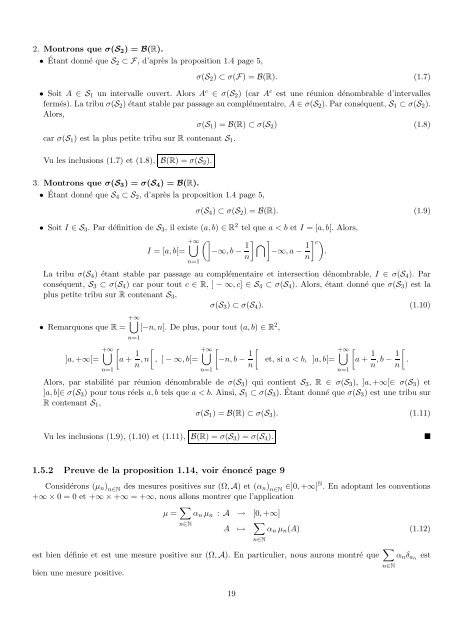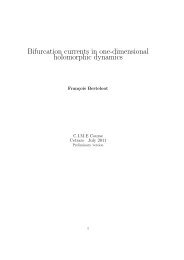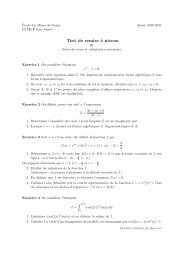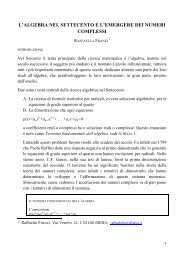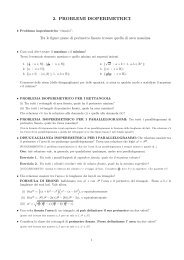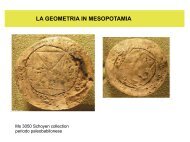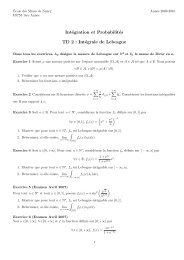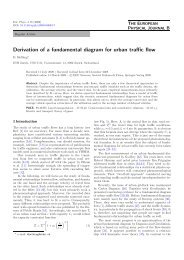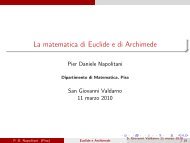Remarque 1.21 Soit (Ω, A,µ) un espace mesuré. Si f : (Ω, A) → (Ω ′ , A ′ ) est mesurable par rapport auxtribus A <strong>et</strong> A ′ , alors f : (Ω, A µ ) → (Ω ′ , A ′ ) est mesurable par rapport aux tribus A µ <strong>et</strong> A ′ car A ⊂ A µ .Exemple 1.121. L’espace (Ω, P(Ω),µ) est toujours compl<strong>et</strong>.2. L’espace mesuré ( R d , B ( R d) ,λ d)n’est pas un espace compl<strong>et</strong>. La tribu complétée(L R d) = B(R d) λ dest appelée tribu de Lebesgue sur R d . Par ailleurs, l’unique mesure prolongeant la mesure de Lebesgueλ d à L ( R d) est toujours notée λ d <strong>et</strong> appelée mesure de Lebesgue sur R d .Lorsque l’on considère des espaces mesurés compl<strong>et</strong>s au sens de la définition 1.32, un des avantages est quesi l’on modifie une fonction mesurable sur un négligeable, on obtient une nouvelle fonction mesurable.Proposition 1.34Soient (Ω, A,µ) un espace mesuré compl<strong>et</strong>.1. Soit f : (Ω, A) → (Ω ′ , A ′ ) une fonction mesurable. Si g est égale µ-presque partout à f, alors lafonction g : (Ω, A) → (Ω ′ , A ′ ) est mesurable.2. Pour tout n ∈ N, considérons X n : (Ω, A) → ( R, B ( R )) une fonction mesurable. Supposons quepour µ-presque tout ω ∈ Ω, la suite (X n (ω)) n∈Nconverge vers une limite notée X(ω) dans R,c’est-à-dire qu’il existe un ensemble négligeable N tel que∀w /∈ Ω, X n (ω) −−−−→n→+∞X(ω).La fonction X n’est donc a priori définie que µ-presque partout. Tout prolongement de X sur Ω estmesurable par rapport aux tribus A <strong>et</strong> B ( R ) .1.5 Annexes1.5.1 Preuve de la proposition 1.6, voir énoncé page 6Soit O (respectivement F) l’ensemble des ouverts (respectivement fermés) de R. Alors, B(R) = σ(O) = σ(F).1. Montrons que σ(S 1 ) = B(R).• Étant donné que S 1 ⊂ O d’après la proposition 1.4 page 5,σ(S 1 ) ⊂ σ(O) = B(R). (1.6)• Soit A ∈ O. L’ouvert A s’écrit comme une réunion dénombrable d’intervalles ouverts, c’est-à-dire queA = ⋃ n∈NA navec A n ∈ S 1 pour tout n ∈ N. La tribu σ(S 1 ) étant stable par réunion dénombrable, A ∈ σ(S 1 ). Parconséquent, O ⊂ σ(S 1 ). Alors, B(R) = σ(O) ⊂ σ(S 1 ) car σ(O) est la plus p<strong>et</strong>ite tribu sur R contenant O.Vu l’inclusion (1.6), B(R) = σ(S 1 ).18
2. Montrons que σ(S 2 ) = B(R).• Étant donné que S 2 ⊂ F, d’après la proposition 1.4 page 5,σ(S 2 ) ⊂ σ(F) = B(R). (1.7)• Soit A ∈ S 1 un intervalle ouvert. Alors A c ∈ σ(S 2 ) (car A c est une réunion dénombrable d’intervallesfermés). La tribu σ(S 2 ) étant stable par passage au complémentaire, A ∈ σ(S 2 ). Par conséquent, S 1 ⊂ σ(S 2 ).Alors,σ(S 1 ) = B(R) ⊂ σ(S 2 ) (1.8)car σ(S 1 ) est la plus p<strong>et</strong>ite tribu sur R contenant S 1 .Vu les inclusions (1.7) <strong>et</strong> (1.8), B(R) = σ(S 2 ).3. Montrons que σ(S 3 ) = σ(S 4 ) = B(R).• Étant donné que S 4 ⊂ S 2 , d’après la proposition 1.4 page 5,n=1σ(S 4 ) ⊂ σ(S 2 ) = B(R). (1.9)• Soit I ∈ S 3 . Par définition de S 3 , il existe (a,b) ∈ R 2 tel que a < b <strong>et</strong> I = [a,b[. Alors,+∞ ⋃(]I = [a,b[= −∞,b − 1 ] ⋂]−∞,a − 1 ] c ).nnLa tribu σ(S 4 ) étant stable par passage au complémentaire <strong>et</strong> intersection dénombrable, I ∈ σ(S 4 ). Parconséquent, S 3 ⊂ σ(S 4 ) car pour tout c ∈ R, ] − ∞,c] ∈ S 4 ⊂ σ(S 4 ). Alors, étant donné que σ(S 3 ) est laplus p<strong>et</strong>ite tribu sur R contenant S 3 ,σ(S 3 ) ⊂ σ(S 4 ). (1.10)• Remarquons que R =]a,+∞[=+∞ ⋃n=1+∞ ⋃n=1[−n,n[. De plus, pour tout (a,b) ∈ R 2 ,[a + 1 [+∞n ,n ⋃, ] − ∞,b[=n=1[−n,b − 1 [n<strong>et</strong>, si a < b, ]a,b[=+∞ ⋃n=1[a + 1 n ,b − 1 [.nAlors, par stabilité par réunion dénombrable de σ(S 3 ) qui contient S 3 , R ∈ σ(S 3 ), ]a,+∞[∈ σ(S 3 ) <strong>et</strong>]a,b[∈ σ(S 3 ) pour tous réels a,b tels que a < b. Ainsi, S 1 ⊂ σ(S 3 ). Étant donné que σ(S 3) est une tribu surR contenant S 1 ,σ(S 1 ) = B(R) ⊂ σ(S 3 ). (1.11)Vu les inclusions (1.9), (1.10) <strong>et</strong> (1.11), B(R) = σ(S 3 ) = σ(S 4 ).1.5.2 Preuve de la proposition 1.14, voir énoncé page 9Considérons (µ n ) n∈Ndes mesures positives sur (Ω, A) <strong>et</strong> (α n ) n∈N∈]0,+∞] N . En adoptant les conventions+∞ × 0 = 0 <strong>et</strong> +∞ × +∞ = +∞, nous allons montrer que l’applicationµ = ∑ n∈Nα n µ n : A → [0,+∞]A ↦→ ∑ n∈Nα n µ n (A) (1.12)est bien définie <strong>et</strong> est une mesure positive sur (Ω, A). En particulier, nous aurons montré que ∑ n∈Nα n δ an estbien une mesure positive.19
- Page 1: Année 2009-2010Intégration et Pro
- Page 6 and 7: Remarque 1.1 En probabilités, un e
- Page 8 and 9: Remarque 1.3 Une tribu étant stabl
- Page 10 and 11: Exemple 1.4 Soient (Ω, A) un espac
- Page 12 and 13: Preuve de la proposition 1.15. Éta
- Page 14 and 15: Donnons à présent la mesure d’u
- Page 16 and 17: 1.3.2 Un exemple : les fonctions é
- Page 18 and 19: Preuve de la proposition 1.29.• S
- Page 22 and 23: 1. Montrons que µ est bien défini
- Page 24 and 25: • Supposons I fini. Nous pouvons
- Page 26 and 27: D’après (i), (ii), (iii) et (iv)
- Page 28 and 29: Exemple 2.1∫1. Supposons que µ =
- Page 30 and 31: Nous pouvons donc considérer une s
- Page 32 and 33: 2.1.3 Intégrale d’une fonction d
- Page 34 and 35: 2.2 Propriétés générales de l
- Page 36 and 37: Nous pouvons énoncer une propriét
- Page 38 and 39: • Étant donné que pour tout n
- Page 40 and 41: Alors, A ∈ A et A c ∈ A car les
- Page 42 and 43: Nous pouvons prolonger F i en une f
- Page 44 and 45: Proposition 2.27 (Riemann-intégrab
- Page 46 and 47: 2.5.3 L’essentiel de la section 2
- Page 48 and 49: • Fixons n ∈ N. Notons que par
- Page 51 and 52: Chapitre 3Loi d’une variable alé
- Page 53 and 54: 3.2 Mesure image et loi d’une var
- Page 55 and 56: De plus, (ϕ n ◦ X) n∈N est une
- Page 57 and 58: 2. Par ailleurs, pour tous réels a
- Page 59 and 60: Preuve de la proposition 3.13. Nous
- Page 61 and 62: ••2. Soit F : R → R une fonct
- Page 63 and 64: 3.4 Variables aléatoires et lois a
- Page 65 and 66: La fonction borélienne f étant po
- Page 67 and 68: 3.4.3 Changement de variablesNous n
- Page 69 and 70: Proposition 3.33 (Fonction de répa
- Page 71 and 72:
Proposition 3.38Soient X une variab
- Page 73 and 74:
Nous commençons par étudier le ca
- Page 75 and 76:
Chapitre 4Espaces L p et L pDans ce
- Page 77 and 78:
Définition 4.3 (Espace L ∞ (Ω,
- Page 79 and 80:
Terminons cette section en remarqua
- Page 81 and 82:
Dans le cas où µ est une mesure b
- Page 83 and 84:
Par suite,‖f + g‖ p p (‖f‖
- Page 85 and 86:
Cette propriété est une conséque
- Page 87 and 88:
4.3 Espaces L p et L p sur un espac
- Page 89 and 90:
4.3.2 InégalitésCommençons par r
- Page 91 and 92:
4.4 Annexes4.4.1 Annexe : Preuve du
- Page 93 and 94:
Étudions à présent les moments d
- Page 95 and 96:
Annexe AClasses monotonesDe nombreu
- Page 97 and 98:
Ce théorème permet de montrer que
- Page 99 and 100:
Annexe BIntégrales dépendant d’
- Page 101 and 102:
Loi de la v.a. X P X Espérance Var
- Page 103:
Bibliographie[1] Barbe, P. et Ledou


